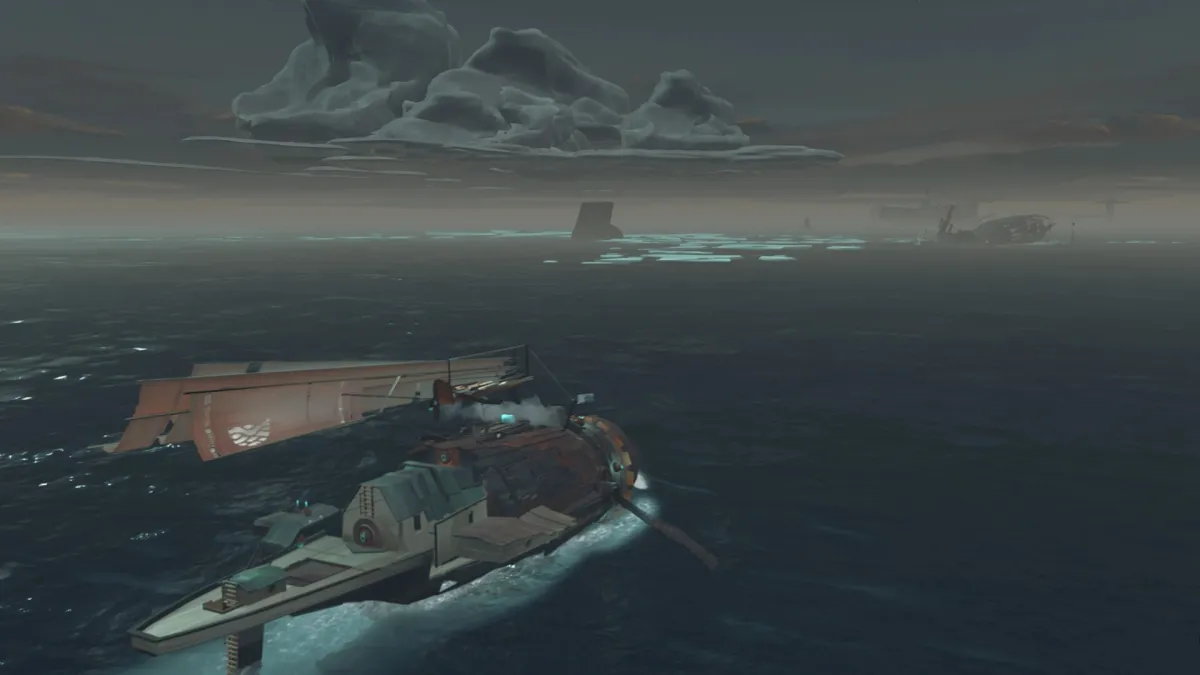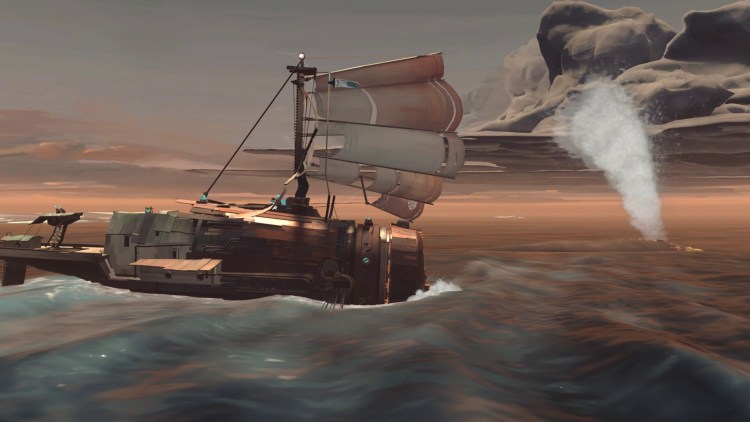Admittedly, I played Far: Lone Sails recently in anticipation of its follow up. I enjoyed it immensely but, to be fair, there wasn’t much about the game to dislike. Lone Sails was a brief, but calming adventure, representative of that special niche of indies designed to help you mellow out while solving uncomplicated puzzles. If you too enjoyed it, then you’ll be happy to know that developer Okomotive hasn’t messed with the recipe much with Far: Changing Tides. Diving right in, the game felt at once as familiar and cozy as a warm sweater.
Granted, there are some clear differences between the two. Instead of roving ever onward on a massive land vehicle, your new mode of transport is a ship sailing upon the seas. Your tiny character is still jump to cross gaps, as well as wander about inside and on the ship. But you’re more capable. You can climb ladders and, appropriate for the new nautical theme, swim underneath the waves. A propeller suit found early in the game lets you hold a button to dart forward under water.
Wander ever yonder
But for the most part, if you have played the previous game, it’s easy to snap back into the motions. After you get acquainted with your vessel, you return to the usual game of playing Bop It with its systems. Junk found scattered about your travels is crunched into fuel that powers a steam engine. Speed is increased by manning the bellows and strengthening the blaze. All the while, you keep an eye on your temperature gauge and use a water hose to cool the engine before it overheats.
You again have sails, but it’s now more involved than simply pressing a button. The button still exists, but once the mast extends skyward, you climb to the top and grab a rope to hook into the ship in order to bring up the canvas. Sliding control sticks allow you to move the sails in order to catch the best angle of the rushing wind. It’s also still a good idea to keep an eye on incoming objects or bridges, as smacking your sails into either can cause damage.
In a bit of a twist, however, you don’t only sail the open waters — you also go underneath. After acquiring a particular upgrade, your ship can turn into a submarine to crawl under the churning waves. It adds a whole new layer to the formula. Generally though, you don’t dive often. It’s mostly contextual, in which you meet up against an object barring your path. And since you can’t bust your way past, you go under, occasionally navigating your delicate ship through narrow caves. These are among the rare moments the normally tranquil Far: Changing Tides can feel a bit nerve-wracking.
You’ll figure it out
Most other times, stops in your expedition invite you to solve some of the game’s light puzzles. Lone Sails was much the same, in which you sleuth out ancient, long-abandoned machinery to re-open a passage. The puzzles are refreshingly breezy, and even in the rare moments where I felt momentarily lost, a solution presented itself once I tried every option.
Solving puzzles during the early game can also grant upgrades for your ship. The aforementioned submarine ability was a reward for one such puzzle. You also get an upgrade that makes your ship temporarily go faster or ram through obstacles. Most of your upgrades get added to your repertoire within the first couple of hours. Afterwards, the game merely challenges you to figure out which and when to use each one.
Breathe it in
Puzzle solving and pressing levers isn’t really what makes Far: Changing Tides (and its predecessor) so alluring, though. Changing Tides is appropriately drenched in atmosphere; calming and meditative, the moments I loved most took place between the action. The game is free of any dialogue, hints, and even a UI. You watch as the orange, painted sky gets swapped for the gloom of night. Placing my character on the bow of the ship, I would sink into my chair an let the lapping of the waves and beautiful, wistful soundtrack wash over me. Okomotive masters the feeling of calming isolation; few other games I’ve experienced can match it quite like Changing Tides and its kin.
Happily, for a game that has as much downtime, I never found it boring. The busier segments will see you scurrying about your ship, feeding the engine and using handheld repair device to fix broken components. A storm may roll in, piercing the dark night with lightning and causing your ship to rock. But it’s over just as quickly as it begun, and you’re back to drifting along.
You can zoom the camera in and out, and at a wider angle you’re able to move your view — even below the surface of the water. I’d suggest doing that from time to time. Far: Changing Tides is a lonely sojourn in a world seemingly devoid of human life. But if you look around, you might spot a fellow animal traveler.
My issues with the game are rare, truth be told. They’re mostly nitpicks about your character’s mobility. You can jump in the game, but at the apex your character drops like a rock. I nearly missed a couple of gaps because of how much my little friend hated heights. Your propulsion under water is also peculiar. When zooming through the water, letting go of the button causes your character to do a dead stop. As I said, nitpicks. But the lack of realistic momentum can be distracting at times.
Toward the distant horizon
The distractions, however, aren’t enough to truly take away from Far: Changing Tides. It’s an attractive, often relaxing game that doesn’t seek to overwhelm you with unnecessary action or exposition. There is lore: the occasional doomsday mural or derelict vessel offer some clues to piece together the stories of the past.
Changing Tides is roughly twice as long as the last game, coming in at around four or five hours. That in mind, those who played Lone Sails will certainly find more to love in its follow up. And for me, I was glad to return the melancholy world of Far. It was a short ride, but certainly one that’s memorable.












Published: Feb 21, 2022 03:00 am